
2.1.6 Cell cycle and mitosis
2.1.6 Cell division, cell diversity and cellular organisation (a-c, +e)
The cell cycle and mitosis - Notes
2.1.6a: the cell cycle
List the stages of the cell cycle in order and outline what happens at each stage. (F)
List the 3 stages of interphase in order and describe what happens at each stage. (F)
List the 2 stages of the mitotic phase and outline what happens at each stage.
Describe the significance of G0 as a phase that cells enter when they leave the cell cycle.
2.1.6b: how the cell cycle is regulated
Outline the role of checkpoints to control the cell cycle. (F)
State 3 examples of checkpoints in the cell cycle, where they occur and what is checked at each checkpoint.
Outline the link between cell-cycle regulation and cancer. (S+C)
2.1.6c: the main stages of mitosis
Define the terms “mitosis”, “chromosome”, “chromatid”, “sister chromatids”, “centromere”, “centrioles”, “spindle fibres”, “homologous pairs”. (F)
Describe how DNA is packaged in a chromosome.
List the stages of mitosis in order. (F)
Draw, and annotate, a diagram for each stage of mitosis to show the events occurring at each stage. (F)
Explain the role of the centrioles and spindle fibres in mitosis.
Describe the process of cytokinesis in animal cells and plant cells (and compare the two). (F)
Draw and label a graph showing the relative quantity of DNA in a dividing cell.
Compare mitotic cell division in animals and plants with asexual reproduction in protoctista, fungi (such as yeast), and prokaryotes. (S+C)
2.1.6e: the significance of mitosis in life cycles
Describe the purpose of mitotic cell division. (F)
List 4 roles of mitotic cell division. (F)
The role of mitotic cell division
Mitotic cell division is used to make genetically identical copies of cells.
It is used for reproduction in single celled eukaryotic organisms and for reproductive cloning in some multi-cellular eukaryotic organisms.
In multicellular organisms it is also used to make more cells for growth, repair, and replacement.
The cell cycle
The cell cycle is not the same as ‘mitosis’. The cell cycle can contain mitosis or meiosis depending on the type of cell being made. Where mitosis is involved it is just one part of the cell cycle.
Here we will talk about the cell cycle that involves mitosis.
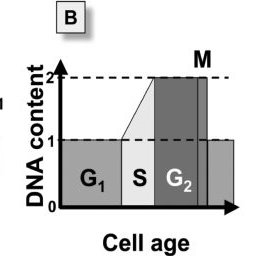 The cell cycle can be split into different stages based around what the cell is doing in each stage:
The cell cycle can be split into different stages based around what the cell is doing in each stage:
Interphase
G1 (Gap/Growth 1)
S (synthesis)
G2 (Gap/Growth 2)
Mitotic phase
Nuclear division (Mitosis)
Prophase
Metaphase
Anaphase
Telophase
Cell division (cytokinesis)
There is also G0.
Cells in G1 can either go through S and the rest of the cell cycle or be directed into G0. This is the stage cells are said to be in if they are not going to go through the cell cycle. This happens to faulty cells that are going to undergo programmed cell death but also to specialised cells that are now unable to do mitosis because of their structural adaptations and because they are doing a job for the organism.
Regulation of the cell cycle
Eukaryotic cells have internal control mechanisms that check that everything is happening as it should as a cell progresses through the cell cycle. The points at which these checks are done are called ‘checkpoints’. There are many checkpoints throughout the cell cycle but the 3 main ones are at the end of G1, at the G2/M transition and during metaphase.
The G1 checkpoint checks whether all conditions are favourable for cell division to occur. Cells check that there are external signals, in the form of growth factors, that mean cell division is an appropriate thing to do. They also check that they are large enough to become two cells and that they have enough energy reserves to successfully go through the cell cycle. Finally, the cell checks for DNA damage.
At the G2/M checkpoint the cell checks that all chromosomes have been accurately replicated (no errors) and that the DNA is not damaged. They also check for sufficient cell size and protein reserves.
The metaphase checkpoint is also called the spindle assembly checkpoint as it check that all the chromosomes are correctly attached to the spindle fibres so that they can be separated correctly in anaphase.
Diploid, haploid, chromosomes and homologous pairs of chromosomes
A gene is a length of DNA that codes for a protein.
An allele is one version of a gene.
In eukaryotic cells the DNA in the nucleus is in the form of linear chromosomes. Each chromosome is one DNA molecule. The DNA molecule is many genes joined together into one long DNA molecule. The genes aren’t joined end to end, there are lengths of ‘non-coding’ DNA between the genes.
In humans there are 46 chromosomes in each cell. There are the sex chromosomes (X and Y for males or two Xs for females) and then 22 types of chromosome that aren’t related to sex determination. These 22 types of chromosome are called autosomal chromosome.
Humans are diploid organisms, that is they have two copies of each type of chromosome in each cell - two sex chromosomes and then two of each autosomal chromosome. These pairs of chromosomes are called homologous pairs.
Each chromosome in a homologous pair has the same genes at the same location (called locus) on the chromosome. Although there may be different versions of the gene (alleles) on each of the two chromosomes in the pair. Homologous chromosomes are also the same size and have their centromeres (the place spindle fibres attach and where sister chromosomes are held together) in the same place.
Diploid cells have two of each chromosome (homologous pairs) whereas haploid cells only have one of each chromosome (no pairs).
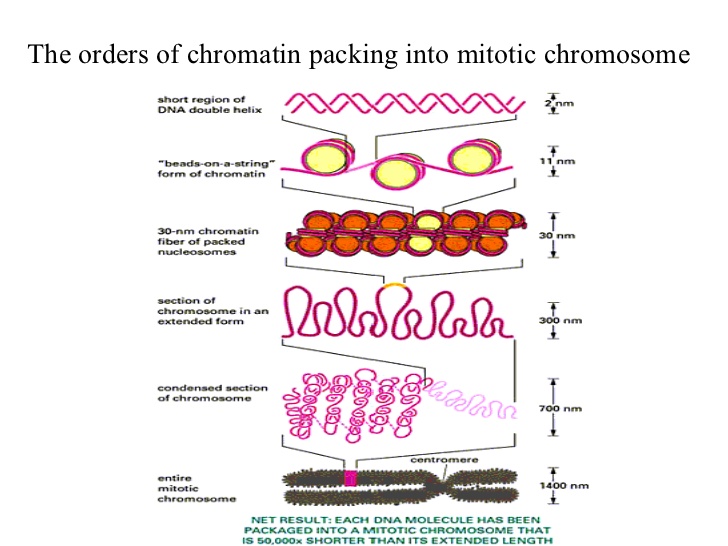 So that they can be moved around in cells during mitosis (or meiosis), chromosomes have to condense. They coil up so much it’s called ‘super coiling’.
So that they can be moved around in cells during mitosis (or meiosis), chromosomes have to condense. They coil up so much it’s called ‘super coiling’.
DNA
DNA is wrapped around histones
Histones coil up tightly
Coils of histones fold up
Super coiling creates condensed chromosomes
This chromosome is duplicated and is composed of two sister chromatids. Each chromatid is a DNA molecule and sister chromatids are identical copies of each other.
The events in the cell cycle
Interphase
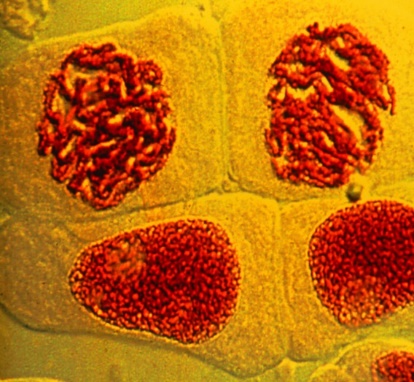 Interphase is the preparation stage for cell division. They just look like ‘normal’ cells however lots is happening to get ready for cell division.
Interphase is the preparation stage for cell division. They just look like ‘normal’ cells however lots is happening to get ready for cell division.
In G1 the cell grows. Cytoplasm volume increases, more plasma membrane is produced, more organelles are produced, and energy and protein stores are built up.
In S the cell replicates its DNA.
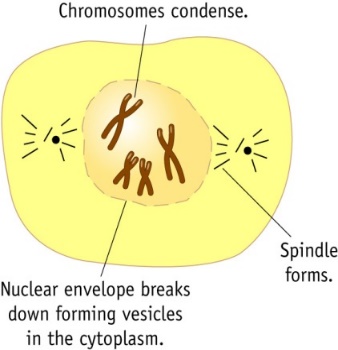 In G2 the cell continues to grow (the same things happen as happened in G1).
In G2 the cell continues to grow (the same things happen as happened in G1).
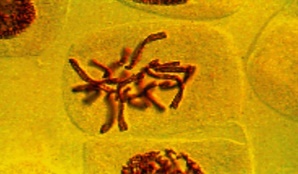 Prophase
Prophase
In prophase the centrioles move to either pole of the cell and they start coordinating spindle fibre (made from microtubules) formation.
The chromosomes condense and the nuclear envelope breaks down.
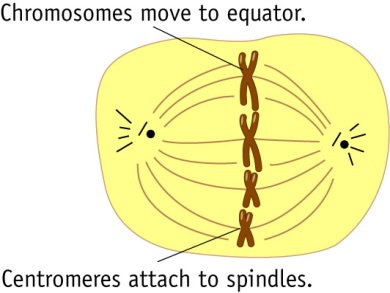
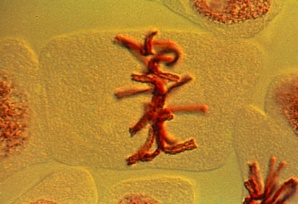 Metaphase
Metaphase
In metaphase the chromosomes line up on the equator of the cell.
The chromosomes attach to the spindle fibres at their centromeres.
 Anaphase
Anaphase
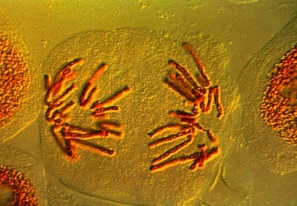 In anaphase the spindle fibres shorten and split the chromosomes into their sister chromatids. Each sister chromatid moves to opposite poles of the cell.
In anaphase the spindle fibres shorten and split the chromosomes into their sister chromatids. Each sister chromatid moves to opposite poles of the cell.
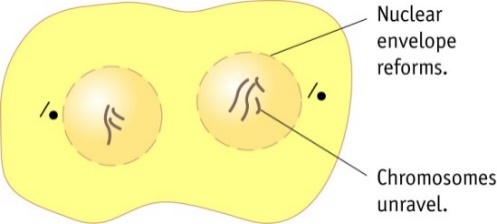
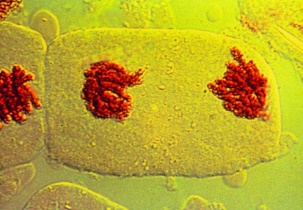 Telophase
Telophase
In telophase the sister chromatids can now be called chromosomes again. A new nuclear envelope forms around each group of chromosomes they start to unravel.
 Cytokinesis
Cytokinesis
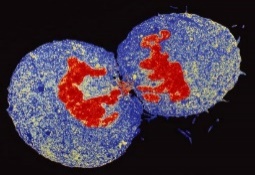
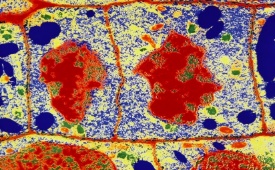 Cytokinesis is cell division. In plants a new cell wall and new plasma membrane form in the middle of the cell (the cell plate). This separates the cell into two.
Cytokinesis is cell division. In plants a new cell wall and new plasma membrane form in the middle of the cell (the cell plate). This separates the cell into two.
In animals, actin filaments make up a contractile ring which pulls the equator of the cell inward creating a cleavage furrow which eventually splits the cell in two.
2.1.6 Cell cycle and mitosis
2.1.6 Cell division, cell diversity and cellular organisation (a-c, +e)
The cell cycle and mitosis - Notes
2.1.6a: the cell cycle
List the stages of the cell cycle in order and outline what happens at each stage. (F)
List the 3 stages of interphase in order and describe what happens at each stage. (F)
List the 2 stages of the mitotic phase and outline what happens at each stage.
Describe the significance of G0 as a phase that cells enter when they leave the cell cycle.
2.1.6b: how the cell cycle is regulated
Outline the role of checkpoints to control the cell cycle. (F)
State 3 examples of checkpoints in the cell cycle, where they occur and what is checked at each checkpoint.
Outline the link between cell-cycle regulation and cancer. (S+C)
2.1.6c: the main stages of mitosis
Define the terms “mitosis”, “chromosome”, “chromatid”, “sister chromatids”, “centromere”, “centrioles”, “spindle fibres”, “homologous pairs”. (F)
Describe how DNA is packaged in a chromosome.
List the stages of mitosis in order. (F)
Draw, and annotate, a diagram for each stage of mitosis to show the events occurring at each stage. (F)
Explain the role of the centrioles and spindle fibres in mitosis.
Describe the process of cytokinesis in animal cells and plant cells (and compare the two). (F)
Draw and label a graph showing the relative quantity of DNA in a dividing cell.
Compare mitotic cell division in animals and plants with asexual reproduction in protoctista, fungi (such as yeast), and prokaryotes. (S+C)
2.1.6e: the significance of mitosis in life cycles
Describe the purpose of mitotic cell division. (F)
List 4 roles of mitotic cell division. (F)
The role of mitotic cell division
Mitotic cell division is used to make genetically identical copies of cells.
It is used for reproduction in single celled eukaryotic organisms and for reproductive cloning in some multi-cellular eukaryotic organisms.
In multicellular organisms it is also used to make more cells for growth, repair, and replacement.
The cell cycle
The cell cycle is not the same as ‘mitosis’. The cell cycle can contain mitosis or meiosis depending on the type of cell being made. Where mitosis is involved it is just one part of the cell cycle.
Here we will talk about the cell cycle that involves mitosis.
 The cell cycle can be split into different stages based around what the cell is doing in each stage:
The cell cycle can be split into different stages based around what the cell is doing in each stage:
Interphase
G1 (Gap/Growth 1)
S (synthesis)
G2 (Gap/Growth 2)
Mitotic phase
Nuclear division (Mitosis)
Prophase
Metaphase
Anaphase
Telophase
Cell division (cytokinesis)
There is also G0.
Cells in G1 can either go through S and the rest of the cell cycle or be directed into G0. This is the stage cells are said to be in if they are not going to go through the cell cycle. This happens to faulty cells that are going to undergo programmed cell death but also to specialised cells that are now unable to do mitosis because of their structural adaptations and because they are doing a job for the organism.
Regulation of the cell cycle
Eukaryotic cells have internal control mechanisms that check that everything is happening as it should as a cell progresses through the cell cycle. The points at which these checks are done are called ‘checkpoints’. There are many checkpoints throughout the cell cycle but the 3 main ones are at the end of G1, at the G2/M transition and during metaphase.
The G1 checkpoint checks whether all conditions are favourable for cell division to occur. Cells check that there are external signals, in the form of growth factors, that mean cell division is an appropriate thing to do. They also check that they are large enough to become two cells and that they have enough energy reserves to successfully go through the cell cycle. Finally, the cell checks for DNA damage.
At the G2/M checkpoint the cell checks that all chromosomes have been accurately replicated (no errors) and that the DNA is not damaged. They also check for sufficient cell size and protein reserves.
The metaphase checkpoint is also called the spindle assembly checkpoint as it check that all the chromosomes are correctly attached to the spindle fibres so that they can be separated correctly in anaphase.
Diploid, haploid, chromosomes and homologous pairs of chromosomes
A gene is a length of DNA that codes for a protein.
An allele is one version of a gene.
In eukaryotic cells the DNA in the nucleus is in the form of linear chromosomes. Each chromosome is one DNA molecule. The DNA molecule is many genes joined together into one long DNA molecule. The genes aren’t joined end to end, there are lengths of ‘non-coding’ DNA between the genes.
In humans there are 46 chromosomes in each cell. There are the sex chromosomes (X and Y for males or two Xs for females) and then 22 types of chromosome that aren’t related to sex determination. These 22 types of chromosome are called autosomal chromosome.
Humans are diploid organisms, that is they have two copies of each type of chromosome in each cell - two sex chromosomes and then two of each autosomal chromosome. These pairs of chromosomes are called homologous pairs.
Each chromosome in a homologous pair has the same genes at the same location (called locus) on the chromosome. Although there may be different versions of the gene (alleles) on each of the two chromosomes in the pair. Homologous chromosomes are also the same size and have their centromeres (the place spindle fibres attach and where sister chromosomes are held together) in the same place.
Diploid cells have two of each chromosome (homologous pairs) whereas haploid cells only have one of each chromosome (no pairs).
 So that they can be moved around in cells during mitosis (or meiosis), chromosomes have to condense. They coil up so much it’s called ‘super coiling’.
So that they can be moved around in cells during mitosis (or meiosis), chromosomes have to condense. They coil up so much it’s called ‘super coiling’.
DNA
DNA is wrapped around histones
Histones coil up tightly
Coils of histones fold up
Super coiling creates condensed chromosomes
This chromosome is duplicated and is composed of two sister chromatids. Each chromatid is a DNA molecule and sister chromatids are identical copies of each other.
The events in the cell cycle
Interphase
 Interphase is the preparation stage for cell division. They just look like ‘normal’ cells however lots is happening to get ready for cell division.
Interphase is the preparation stage for cell division. They just look like ‘normal’ cells however lots is happening to get ready for cell division.
In G1 the cell grows. Cytoplasm volume increases, more plasma membrane is produced, more organelles are produced, and energy and protein stores are built up.
In S the cell replicates its DNA.
 In G2 the cell continues to grow (the same things happen as happened in G1).
In G2 the cell continues to grow (the same things happen as happened in G1).
 Prophase
Prophase
In prophase the centrioles move to either pole of the cell and they start coordinating spindle fibre (made from microtubules) formation.
The chromosomes condense and the nuclear envelope breaks down.

 Metaphase
Metaphase
In metaphase the chromosomes line up on the equator of the cell.
The chromosomes attach to the spindle fibres at their centromeres.
 Anaphase
Anaphase
 In anaphase the spindle fibres shorten and split the chromosomes into their sister chromatids. Each sister chromatid moves to opposite poles of the cell.
In anaphase the spindle fibres shorten and split the chromosomes into their sister chromatids. Each sister chromatid moves to opposite poles of the cell.

 Telophase
Telophase
In telophase the sister chromatids can now be called chromosomes again. A new nuclear envelope forms around each group of chromosomes they start to unravel.
 Cytokinesis
Cytokinesis

 Cytokinesis is cell division. In plants a new cell wall and new plasma membrane form in the middle of the cell (the cell plate). This separates the cell into two.
Cytokinesis is cell division. In plants a new cell wall and new plasma membrane form in the middle of the cell (the cell plate). This separates the cell into two.
In animals, actin filaments make up a contractile ring which pulls the equator of the cell inward creating a cleavage furrow which eventually splits the cell in two.
 Knowt
Knowt